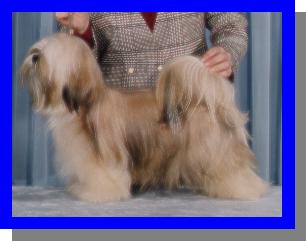 The Lhasa Apso has been bred in Tibetan monasteries for 2000 years. The dogs were regarded as good luck talismans that kept evil away, and were never sold but given as gifts to those the lamas held in high esteem. In its country of origin the breed was esteemed as companion and watch dogs. It is said that the Tibetan Mastiff stood guard outside the homes and monasteries while the little Lhasa gave warning of any intruder that might have slipped indoors. They were trained to be warning dogs and taught to distinguish between residents and strangers.
The Lhasa Apso has been bred in Tibetan monasteries for 2000 years. The dogs were regarded as good luck talismans that kept evil away, and were never sold but given as gifts to those the lamas held in high esteem. In its country of origin the breed was esteemed as companion and watch dogs. It is said that the Tibetan Mastiff stood guard outside the homes and monasteries while the little Lhasa gave warning of any intruder that might have slipped indoors. They were trained to be warning dogs and taught to distinguish between residents and strangers.
By nature these dogs are especially well equipped for the job. They possess a keen sense of hearing, an innate intelligence, and, although they are an obedience-type dog, are independent of mind. For these reasons they continue to make excellent house dogs.
Some claim that the name Lhasa Apso is derived from Rapso, meaning shabby or fluffy mouth. When the dogs coat is long and unkempt he resembles a small Tibetan goat. Other opinion holds that the name comes from Apso Seng Kye, which means Barking Lion Sentinel Dog, and that the breed symbolizes the mythical snow lion, (white with a blue mane) the protector of Buddha. Legend has it that Lamas who failed to reach Nirvana were reincarnated as Lhasa Apsos.
Lhasas are also known as “Jelly Bean Dogs” as they come in a variety of colors. All colors are accepted equally, white, parti-colored, black, golden, sandy, honey, dark grey, grizzle, brown, and blue.
In 1928 Lieutenant Colonel and Mrs. Eric Bailey returned from service in Tibet. Due to his friendship with the Dalai Lama, Lieutenant Colonel Eric Bailey exchanged gifts with the Dalai Lama and was presented with a gift of two dogs. In all he received seven dogs.
First called the Lhasa Terrier, the breed name was changed to Lhasa Apso after the formation of the Tibetan Breeds Association in Britain in 1934. In that same year breeding on that continent got off to a good start with stock imported from the Dalai Lama.
The first Canadian registrations were recorded in 1934 under the breed name Lhasa Terrier and classified in the Terrier Group. Subsequently the name was changed to the present one, and in January 1974, the Lhasa Apso was reclassified, and is now regarded as a member of the Non-Sporting Group in Canada (as it is in the United States). RETURN TO HOME PAGE